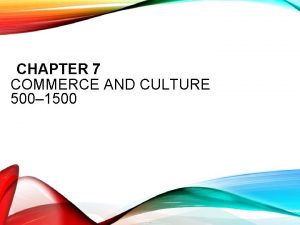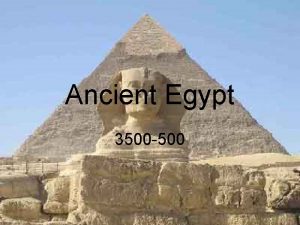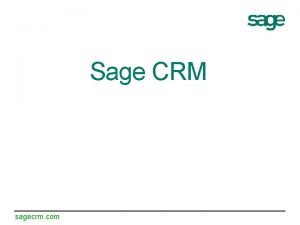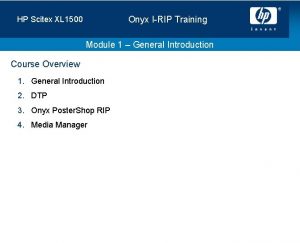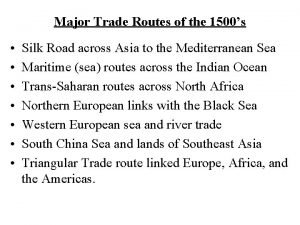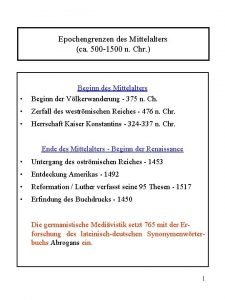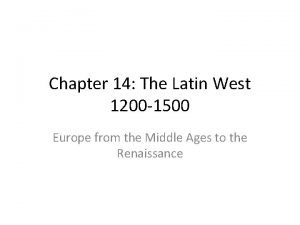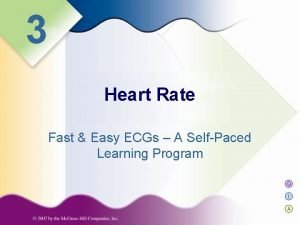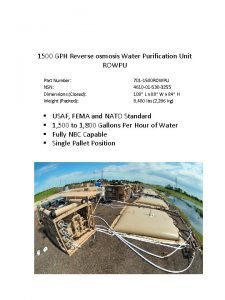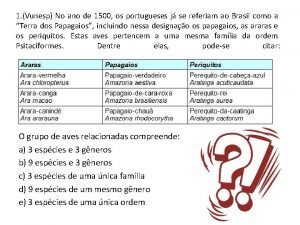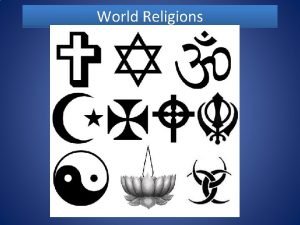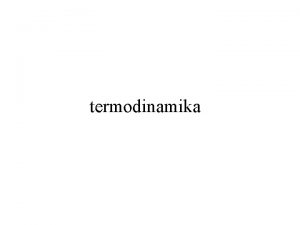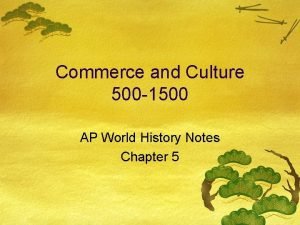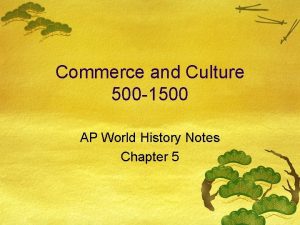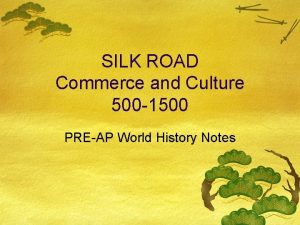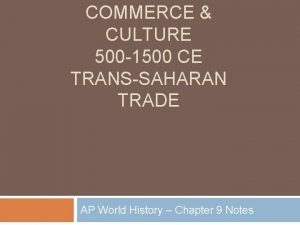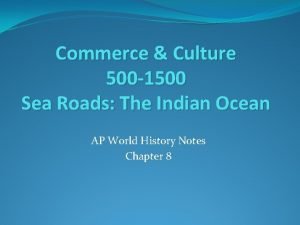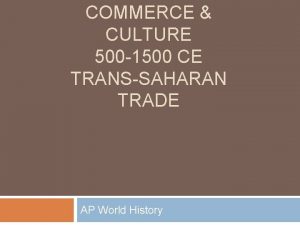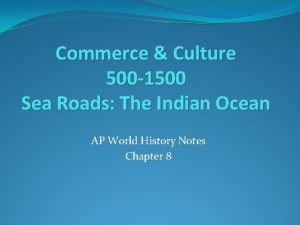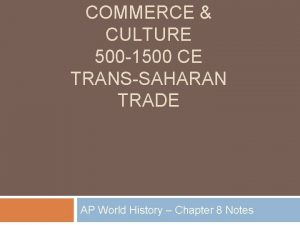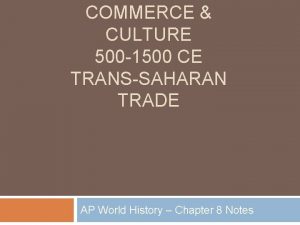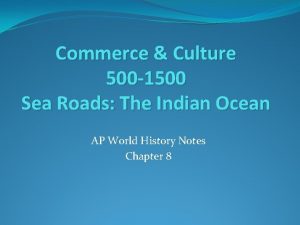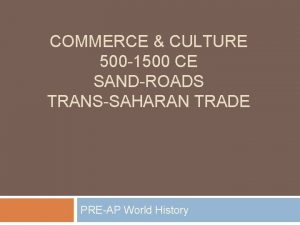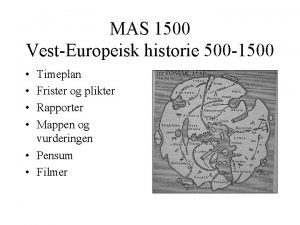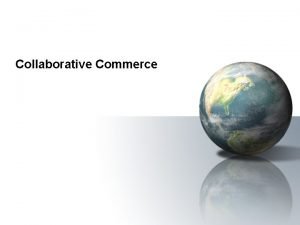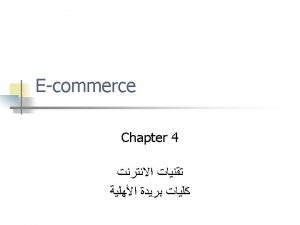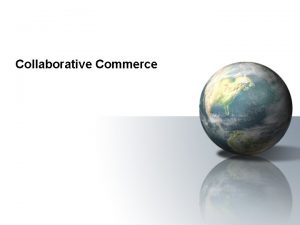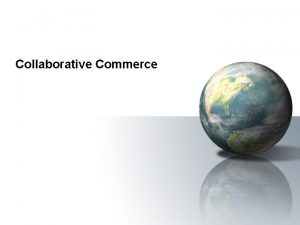CHAPTER 7 COMMERCE AND CULTURE 500 1500 I







































- Slides: 39

CHAPTER 7 COMMERCE AND CULTURE 500– 1500 .


I. SILK ROADS: EXCHANGE ACROSS EURASIA A. The Growth of the Silk Roads 1. Inner and Outer Eurasia a. The Eurasia land mass, home to the majority of the world’s population and many of its most economically productive areas, is divided by geography and historical development. In India, China, the Middle East, and the Mediterranean, there were a series of economically vibrant urban centers, states, and empires. These civilizations were on the periphery of the continent, “outer” Eurasia. Between them lay the colder plains and steppes of “inner” Eurasia. These lands were home to nomadic pastoral groups with herd animals.

I. SILK ROADS: EXCHANGE ACROSS EURASIA 2. Pastoral people in motion. a. These nomadic pastoralists raised animals and traded animal products with the people of the outer zone. They also began to carry products from one area to another. 3. Indirect connections between empires. a. These pastoralists served as an indirect method of communication between the empires of the outer zone.


I. SILK ROADS: EXCHANGE ACROSS EURASIA B. Goods in transit 1. Luxury goods such as silk a. Staples and other foodstuffs were too heavy to carry on the Silk Roads. Because of the cost of long-distance transportation, the trade network thus carried lightweight and expensive items, especially silk and spices.

I. SILK ROADS: EXCHANGE ACROSS EURASIA 2. Women as producers and consumers: a. For centuries, Chinese silk was produced by Chinese female peasants and consumed by elite Chinese women. Increasingly, elite men such as government officials and religious figures in China and elsewhere began to demand silk. Europeans used silk for clothes and wall hangings.

I. SILK ROADS: EXCHANGE ACROSS EURASIA 3. China and other centers of silk production: a. China enjoyed a monopoly on silk production for centuries, but by the sixth century, the knowledge of how to make silk spread to the Byzantine Empire and various sites in Asia. As supply increased, the various types of silk and various uses for it also increased.

I. SILK ROADS: EXCHANGE ACROSS EURASIA C. Cultures in Transit Buddhism on the road a. Buddhism spread along the Silk Roads, gaining converts among pastoral peoples and in oasis towns. Many monasteries were established that became centers of wisdom and learning, as well as serving economic functions. Buddhism’s universal message had a strong appeal to the cosmopolitan merchant world of Inner Eurasia. 2. New forms of Buddhism: Mahayana a. As Buddhism left India, doctrine changed. The Mahayana branch became the most predominant. Mahayana Buddhism saw the Buddha as a god-like figure, encouraged the veneration of Bodhisattvas, and stressed various rituals. Wealthy monasteries began to get involved in political and economic affairs along the Silk Roads. In Bactria, Greek culture influenced Buddhist art and culture. 1.


I. SILK ROADS: EXCHANGE ACROSS EURASIA D. Disease in Transit 1. Smallpox and measles in Han and Rome a. These diseases caused various epidemic outbreaks in both empires on either end of Eurasia. 2. Bubonic plague in Byzantium and elsewhere a. : Between 534 and 750 C. E. , bubonic plague broke out at various times in various places around the Mediterranean. Sometimes these outbreaks could kill thousands in a day as in a 40 -day epidemic in Constantinople in 534. 3. Mongols and the Black Death a. The most famous case of epidemic disease was the Black Death. Spread during the Mongol control of the Silk Roads, it moved from China to Europe and the Middle East. It killed one-third of the European population between 1346 and 1350.


II. SEA ROADS: EXCHANGE ACROSS THE INDIAN OCEAN A. Weaving the Web of an Indian Ocean World 1. Malay sailors in East Africa a. The regular wind patterns of the monsoons in the Indian Ocean allowed for fairly easy and consistent travel. While there has been local maritime trade in the Indian Ocean for an unknown time, in the first millennium B. C. E. , Malay sailors began to make longdistance travels across the ocean. They brought various crops such as bananas and coconuts as far as East Africa. There are still various cultural traces of these Malay voyagers in Africa.

II. SEA ROADS: EXCHANGE ACROSS THE INDIAN OCEAN 2. New technologies a. The development of new technologies for shipbuilding and navigation allowed sailors from various locations around the Indian Ocean to engage in sea-going trade. These technologies included ships known as junks with stern rudders, keels that gave more stability, the astrolabe, and the compass.

II. SEA ROADS: EXCHANGE ACROSS THE INDIAN OCEAN 3. India as the fulcrum a. Thanks to both its central geographic location and its vibrant economy, India naturally became the fulcrum of trade in the Indian Ocean basin. 4. Impact of China a. The economic revival of the Tang and Song (618– 1279) gave a huge economic boost to the Indian Ocean trade. China produced a variety of goods for export to the rest of the world, increasing the volume of trade on these sea routes. China also served as a market for a variety of Indian and Southeast Asian goods.

II. SEA ROADS: EXCHANGE ACROSS THE INDIAN OCEAN 5. Islam and trade a. The rise of Islam also had a positive impact on trade for several reasons. First of all, as the Prophet Muhammad had been a merchant, he served as a positive role model for other merchants (in contrast to China where merchants were deemed to be of dubious moral quality). Second, as the realm of Islam expanded rapidly, it created a single political system that incorporated a number of different economic centers. In the Indian Ocean, Islam created an international maritime culture.

II. SEA ROADS: EXCHANGE ACROSS THE INDIAN OCEAN B. Sea Roads as a Catalyst for Change: Southeast Asia 1. Srivijaya, 670– 1075 a. This Sumatra-based kingdom owed its power to the control over the flow of trade through the Straits of Malacca. With access to supplies of gold and spices and the taxes it collected from ships passing through this crucial choke point in trade between the Indian Ocean and East Asia, Srivijaya became a fabulously wealthy and cosmopolitan place.

II. SEA ROADS: EXCHANGE ACROSS THE INDIAN OCEAN 2. Khmer kingdom of Angkor, 800– 1300 a. Centered in what is now Cambodia, this state had a strong agricultural base but also traded forest products with Chinese and Indian merchants. 3. Borobudur and Angkor Wat The first is a massive Buddhist monument in Java built by the Sailendra dynasty. The three miles of walkways tell the stories of the lives of the Buddha but are set in Java, not India. Angkor Wat is one of many Khmer monuments. It is a Hindu temple whose central tower symbolizes Mt. Meru, the cosmological center of the universe.

II. SEA ROADS: EXCHANGE ACROSS THE INDIAN OCEAN 4. “Indianization” a. Because of the strong economic, religious, and cultural influences from South Asia, many scholars once spoke of a process of the “Indianization” of Southeast Asia. While the impact of India is undeniable, we should not overstate this process as Southeast Asian cultures blended imports from India with their own ideas, traditions, and practices. For example, Southeast Asian women had many more opportunities than their sisters in South Asia.




II. SEA ROADS: EXCHANGE ACROSS THE INDIAN OCEAN C. Sea Roads as a Catalyst for Change: East Africa 1. Swahili a. This was the civilization of coastal East Africa. While they were of Bantu descent, they created a new identity thanks to their participation in the Indian Ocean trade networks. 2. Rise of Islamic trade a. While the Swahili coast had traded with merchants from the north for centuries, the rise of Islam marked a dramatic turning point in the region’s fortunes. Swahili merchants exported the goods and sometimes slaves of the African interior to the markets of India, Southeast Asia, and China. Conversely, they imported goods such as Indian gold art and Chinese porcelain.

II. SEA ROADS: EXCHANGE ACROSS THE INDIAN OCEAN 3. Lamu, Mombasa, Kilwa, and Sofala a. The Swahili culture was an urban culture composed of independent city-states of perhaps 20, 000 people. Despite a common language and culture, there was no political unity. These societies had intense social stratification between elites and commoners. 4. Cultural fusions a. The Swahili cities were home to a rich fusion of various cultures from Africa, the Middle East, and Asia. The Swahili language, for example, is of Bantu origin but uses Arabic script and has many Arabic loan words.

II. SEA ROADS: EXCHANGE ACROSS THE INDIAN OCEAN 5. Muslim Africans a. With the spread of Islam, the East Coast of Africa was home to a large population of Muslims who did not trace their roots back to the Arabian Peninsula but did see themselves as a part of the larger Islamic community. As Muslims, they saw fellow black Africans who did not practice Islam as outsiders. They thus felt they had more in common with Arabs and Persians than animist Africans. 6. Great Zimbabwe a. The Swahili merchants forged links with peoples of the interior of the continent as well as further south. To the south and inland from the coast lay the impressive kingdom of Great Zimbabwe with large stone buildings in its capital, indicating much wealth and social organization.


III. SAND ROADS: EXCHANGE ACROSS THE SAHARA A. Commercial Beginnings in West Africa 1. Environmental variation around the Sahara a. There are diverse environments in and around the Sahara, each producing a different set of goods. To the north on the shores of the Mediterranean were communities that produced goods such as weapons, tools, books, clothes, and glassware. The Sahara had deposits of copper and salt as well as oases with date palms. To the immediate south in the savanna grasslands, there were millet and sorghum farmers; further south in the forests, root and tree crops such as yam and kola nuts grew.

III. SAND ROADS: EXCHANGE ACROSS THE SAHARA 2. Sudanic West African trade and urban centers a. Arab travelers knew the lands south of the Sahara as the “Sudan” or “land of the blacks, ” but there were older trade networks amongst the people of West Africa. There were a number of urban centers along the Niger River that were key hubs of trade.

III. SAND ROADS: EXCHANGE ACROSS THE SAHARA B. Gold, Salt, and Slaves: Trade and Empire in West Africa 1. Camel caravans carrying gold and salt a. The introduction of the camel changed the course of trade in Africa. Now massive caravans of hundreds of people and thousands of camels could bring salt and other goods from the north across the dangerous Sahara in exchange for gold and other goods from the south. Soon Arab merchants would bring the news of the Islamic revelations to West Africa.

III. SAND ROADS: EXCHANGE ACROSS THE SAHARA 2. Wealthy empires based on trade a. Several empires such as Ghana, Mali, and Songhay developed into wealthy states thanks to their monopoly control over the Sahara trade routes and their access to plentiful gold deposits. 3. Women in the workforce a. While men generally enjoyed positions of patriarchal power, women played important roles in court and in the workforce as agricultural laborers and the makers of craft goods such as pottery.

III. SAND ROADS: EXCHANGE ACROSS THE SAHARA 4. Slave trading a. Like elsewhere in the world, there were various forms of slavery. Slaves were generally taken from stateless societies further to the south, but some wealthy men had women from the eastern Mediterranean as slaves. Slaves were also exported to the Islamic slave markets of the north. 5. Cosmopolitan cities a. The wealth of the West African cities made them centers of trade and manufacturing but also culture, education, and religion.




IV. AN AMERICAN NETWORK: COMMERCE AND CONNECTION IN THE WESTERN HEMISPHERE 1. Geographic barriers a) Unlike Eurasia with its easy east-west trade axis, the Americas had serious obstacles to travel in the jungles of the narrow Isthmus of Panama. 2. Regional trade networks a) The Americas did have a series of regional trade networks that could move goods and cultural practices over hundreds of miles.

IV. AN AMERICAN NETWORK: COMMERCE AND CONNECTION IN THE WESTERN HEMISPHERE 3. Mayan and Aztec trade a) The Mesoamerican states such as the Mayan and the Aztecs made themselves wealthy by controlling the trade routes through their territory. While much of the trade was in luxury goods, it often provided essential items from distant ecosystems. In the Aztec realm, there were professional merchants called pochtecatl who acted for the state or on their own. 4. Incan roads a) The Inca used their 20, 000 -mile road system to run a state-controlled trade network of various commodities from the diverse lands they controlled.



 Commerce and culture chapter 7
Commerce and culture chapter 7 Location-based commerce (l-commerce)
Location-based commerce (l-commerce) 3500 / 500
3500 / 500 Non material culture definition
Non material culture definition Batch culture vs continuous culture
Batch culture vs continuous culture American culture vs indian culture
American culture vs indian culture Stroke culture method
Stroke culture method Folk culture and popular culture venn diagram
Folk culture and popular culture venn diagram Folk cultures are spread primarily by
Folk cultures are spread primarily by Anaerobic medium
Anaerobic medium Folk culture and popular culture venn diagram
Folk culture and popular culture venn diagram Carpet culture method
Carpet culture method Carpet culture method
Carpet culture method Surface culture deep culture and esol
Surface culture deep culture and esol Sociologists define a symbol as
Sociologists define a symbol as Batch culture vs continuous culture
Batch culture vs continuous culture Characteristics of collectivism
Characteristics of collectivism Counterculture vs subculture
Counterculture vs subculture Adaptive culture from inert culture
Adaptive culture from inert culture Characteristics of quality culture
Characteristics of quality culture America africa and europe before 1500
America africa and europe before 1500 Chapter 2 the internet the web and electronic commerce
Chapter 2 the internet the web and electronic commerce Middle english period 1066-1500
Middle english period 1066-1500 Sage
Sage Un helicoptero que vuela a una altura de 1500 m
Un helicoptero que vuela a una altura de 1500 m Hp scitex xl 1500 price
Hp scitex xl 1500 price Cisco ssl appliance 1500
Cisco ssl appliance 1500 1500s trade routes
1500s trade routes 1500-1382
1500-1382 1500 n chr
1500 n chr Life expectancy evolution
Life expectancy evolution Renaissance europe 1500 map
Renaissance europe 1500 map 1500 method ecg
1500 method ecg Guillaume de machault
Guillaume de machault How to calculate heart rate from ecg with irregular rhythm
How to calculate heart rate from ecg with irregular rhythm Rowpu 1500 technical order
Rowpu 1500 technical order Se reunirmos as famílias canidae cães ursidae
Se reunirmos as famílias canidae cães ursidae 1500 dead in hawaii congress votes war
1500 dead in hawaii congress votes war What is islam's sacred text
What is islam's sacred text Cp-cv=r/m
Cp-cv=r/m
